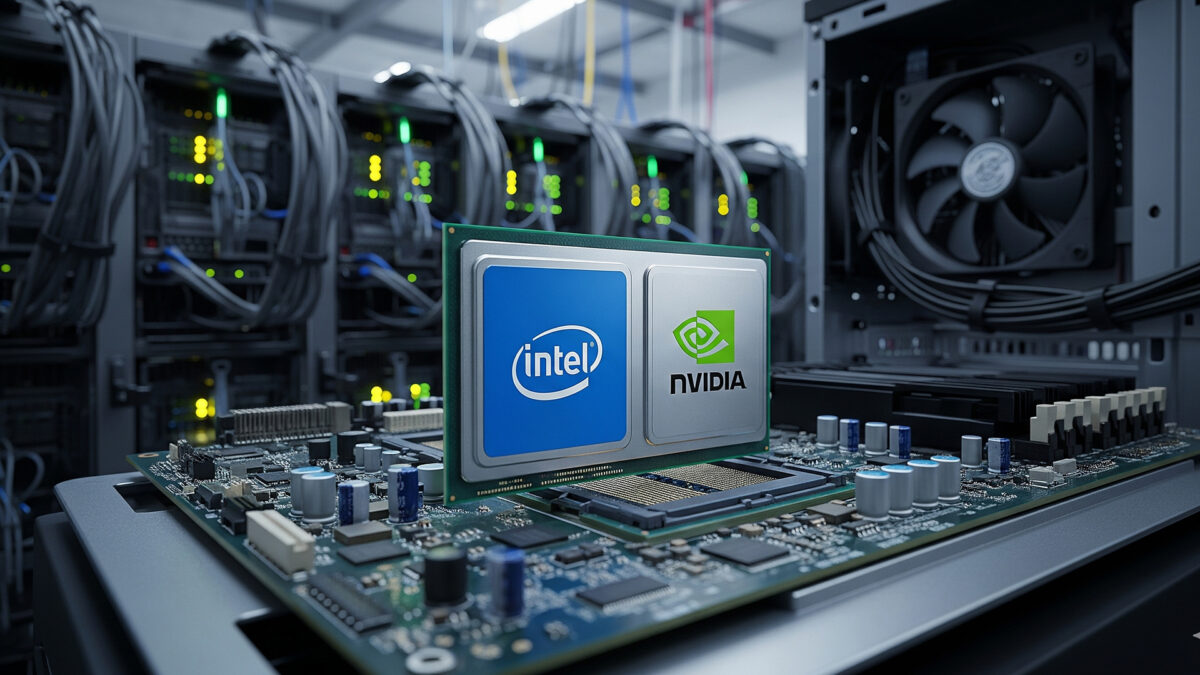Nvidia stunned markets and the semiconductor industry on September 18, 2025, when it announced a strategic partnership with Intel that includes a $5 billion purchase of Intel common stock and a multi-year collaboration to co-develop chips for data centers and personal computers.
Nvidia said it will buy Intel shares at $23.28 apiece — a purchase that would give it roughly a 4 percent stake in the long-troubled chipmaker — and that the two companies will work on “multiple generations” of custom x86 data-center CPUs and new Intel x86 System-on-Chips (SoCs) that integrate Nvidia RTX graphics.
The deal represents an extraordinary rapprochement between the world’s most valuable chip designer and one of the industry’s oldest names.
Nvidia’s chief executive described the move as a strategic step to deepen its data-center and PC ecosystem, while Intel framed the agreement as a validation of its turnaround efforts and a way to accelerate its roadmap for advanced manufacturing and product co-development.
The companies said specifics of jointly developed products would be revealed in stages, but they emphasised that designs will span both server CPUs used in AI infrastructure and client chips for laptops and desktops that pair Intel compute with Nvidia RTX graphics.
Markets reacted immediately. Intel shares surged more than 25 percent as investors cheered the cash infusion and the signal of renewed commercial relevance; reports placed intraday gains in the range of roughly 24–33 percent depending on the exchange and time of trading. Nvidia’s stock also rose, though far more modestly, climbing roughly 3–4 percent as the market weighed the strategic merits of the tie-up.
Rival chipmakers such as AMD saw share weakness amid concerns that a closer Intel-Nvidia axis could reconfigure competitive dynamics in data-center and PC segments.
Why this matters beyond the immediate market rally is twofold. First, Nvidia gains a significant, long-term alignment with a major x86 CPU vendor at a time when its AI products increasingly rely on tight integration with processors and interconnects.
Second, Intel — which has struggled in recent years with manufacturing delays and competitive pressure — secures both a large capital boost and a marquee partner that could help drive customer interest in Intel-based platforms.
Analysts note, however, that the deal stops short of guaranteeing a major manufacturing contract for Intel; Nvidia continues to rely on external foundries like TSMC for much of its highest-end silicon production, and details about where and how the new chips will be manufactured were left deliberately vague.
Industry watchers flagged potential geopolitical and strategic implications.
The partnership could reshape supply-chain relationships, put pressure on Taiwan Semiconductor Manufacturing Company (TSMC) as a supplier to both rivals and partners, and prompt closer scrutiny from regulators given the centrality of chips to national economic and security strategies.
At the same time, some analysts cautioned that bringing two large engineering organisations into a long, complex co-development process carries execution risk: aligning roadmaps, achieving performance targets, and choosing manufacturing partners are all hard problems that could blunt the deal’s near-term commercial impact.
For customers and the broader tech ecosystem, the announcement promises new product architectures in which Intel CPUs and Nvidia GPUs are designed to work more tightly together, potentially simplifying procurement and performance tuning for AI workloads.
Whether the partnership delivers tangible advantages over existing combinations of Nvidia accelerators with ARM or AMD CPUs will depend on execution and on how the companies allocate production and engineering resources across competing priorities.
In short, Nvidia’s $5 billion investment is both a financial vote of confidence in Intel and a strategic opening of a new chapter in the chip industry.
The market’s euphoric response reflects that promise, but the long road from announcement to product — and from product to profitable market share — contains many technical, commercial and regulatory hurdles that both companies will now have to clear.
